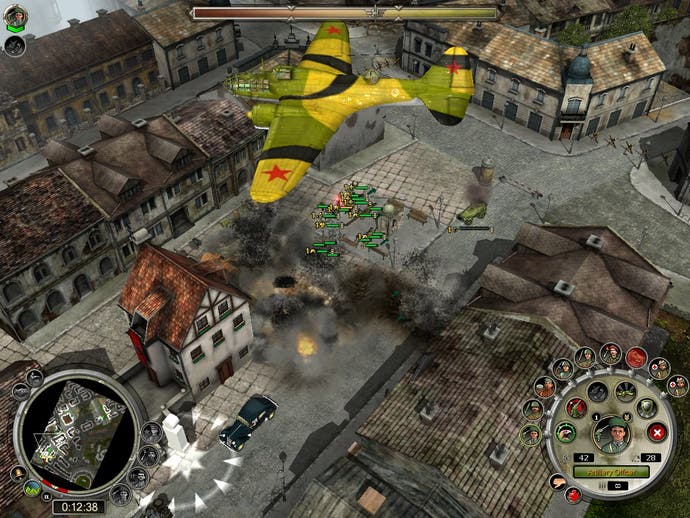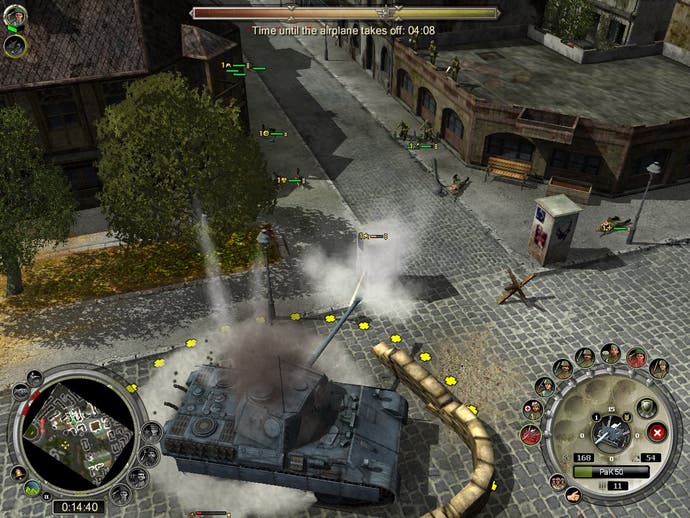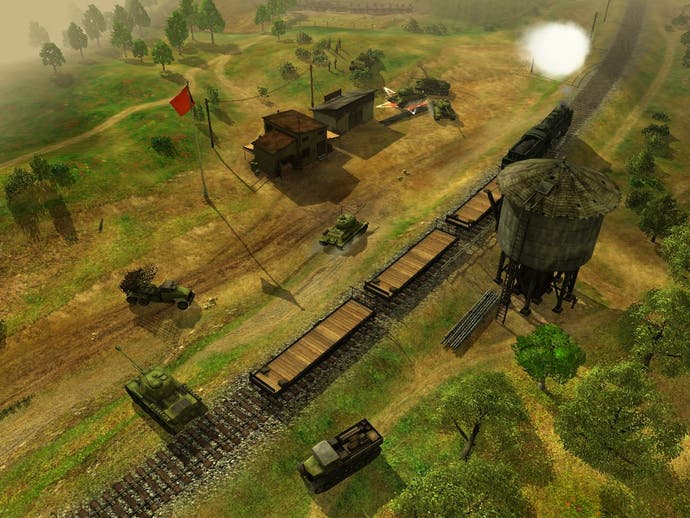Rush for Berlin
German capital hosts 1945 World Cup final.
If you ever want to learn the meaning of the old adage 'Sow the wind, reap the whirlwind' read a good history of the Third Reich. In 1945, the tide of evil that Hitler had unleashed on the Soviet Union in '41 rolled back into the Fatherland like a karmic tsunami. The unstoppable Red Army, taught to look upon Germany as the lair of the beast, stormed through neat and prosperous Prussia, Pomerania and Silesia, destroying, looting and raping as it went. Insane orders from Berlin forced tens of thousands of Axis soldiers and Volkssturm (a civil defence force of old men and boys) to stand in its path and perish. The horror and the suffering was unimaginable...
And completely unsuitable for a PC strategy game, hence Rush For Berlin, another entertaining if unadventurous RTS that works hard to replicate the look and the sound of WW2 battles but shows no interest whatsoever in the tactics or the trauma.
Like Stormregion's previous output (the Codename Panzers titles) this is a game where you can safely skip the tutorials and leave the manual in the box. With a sleek, friendly interface and no base-building or economics, play pretty much boils down to shepherding herds of infantry and tanks around attractive 3D battlefields. Sometimes you'll seize a barracks or a factory (these allow you to produce reinforcements) occasionally you'll activate officer abilities, or call in an artillery barrage or air attack, but most of the time it's attack-move, attack-move, attack-move until the job gets done.
From the Bulge to the Black Sea

Gameplay this simple, this familiar, obviously puts a massive load on the shoulders of scenario designers and AI programmers. In the case of RFB, the former folk seemed to have coped slightly better with the pressure than the latter. Although none of the 25 missions that make up the four sequential campaigns (Russian, German, Western Allies, French) are what you'd call memorable, most were sufficiently well constructed to keep me attentive for the 30 minutes they took to complete. Typically each scenario features two or three compulsory objectives, plus a few optional and secret goals. The settings tend to be loosely inspired by real events so, at various times you find yourself trudging the snowy forests of the Ardennes dodging disguised Panzers, shooting at fleeing ships from the ruined quayside of Sevastopol, and assaulting the Seelow Heights backed by batteries of massive searchlights (one of Marshal Zhukov's less brilliant ideas). Time limits and preposterous secret tunnels are pleasingly rare.
One constant, whether you're in Belgium or Belarus, Bavaria or Belgrade, is the low IQ of the opposition. Enemy infantry often stand about in open fields and streets even when there's good cover to be had a few feet away. Enemy vehicles are equally reckless, usually preferring to sit tight and die when caught in rocket or mortar barrages. The closest computer-controlled forces come to cleverness is manning any abandoned vehicles they come across (all empty tanks and guns can be commandeered) and concentrating fire on repair trucks (possibly the most useful units in the game) Hardly amazing behaviours when you consider what units are capable of in games like Soldiers: Heroes of World War II and Close Combat, but still.

Even if grunts and tank crews showed some fear occasionally, RFB would still get sneered at by the wargamers thanks to its armour penetration model (or, more accurately, its lack of one) and cropped line-of-sight. Like most devs of mainstream WW2 strategy, Stormregion hasn't dared to model armoured vehicles as the highly vulnerable death traps they actually were. Pushing your Sherman down a street in this game, you don't have to worry that some Hitler Youth with a Panzerfaust is going to pop out from behind a wrecked tram and, with one shot, instantly turn your M4 into a blazing funeral pyre. No, the vehicles all have hit-point bars that must be chipped away doggedly with repeated hits. You also don't have to worry about dug-in King Tigers clobbering you Combat Mission-style from hills 2km away: most units are blind to anything more than 100 metres distant.
Dogs of war
Though RFB can't compete with the big war games in terms of realism, it could teach them a thing or two about presentation and campaign continuity. Every mission is sandwiched between two cut-scenes (usually excellent) and preceded by an exemplary briefing incorporating an animated 3D battlefield view. Before each fight you also get to pick your units from a pool filled with grizzled old friends and new recruits (unlocked via those optional objectives mentioned earlier). It's a simple device but does promote a pleasing culture of care. The units themselves are a mix of the predictable - Shermans, Tigers, rifle squads, mortar teams etcetera - and the relatively novel. Along with various German prototype weapons such as the ill-conceived Maus, you get to control RTS rarities like the Locust and Skink (two Allied AFVs) and destroy Panzers with dog-delivered demolition charges. (It did happen! Sort of.)

Multiplayer modes are surprisingly diverse and inventive. As well as refreshingly brief deathmatches and the chance to play campaign scenarios with a friend, there are imaginative 'RISK' matches where players are randomly assigned secret mission goals and 'RUSH' contests where everyone scraps Domination-style over a set of strategic locations. The AI can play as any or all of the sides in these modes but does struggle to get its head round some of the styles.
Appropriately, RFB shows the odd sign of being rushed. Occasionally, during map loading, the game crashes harder than a de-winged B-17. The devs are aware of the problem and a fix seems likely.
Right, I suppose you'll be wanting a score then, and some parting words of wisdom. How about a six (Anything more would ignore the lack of freshness, and the fact you can pick-up equally good alternatives like Blitzkrieg 2 and Codename Panzers: Phase One for less than a tenner) and a quick reminder that the promising Company of Heroes and Faces of War are just a few months away. Both of these titles look likely to offer a more thrilling, more original interpretation of WW2 warfare than Rush For Berlin.
